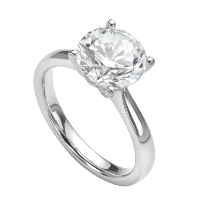A “How To” for cleaning and caring for your jewellery at home.
Choosing the best method of cleaning your jewellery usually depends on the metals that make up your piece of jewellery.
Most rings are composed of gold, whether it is yellow, white or rose gold – or an alloy mixture. Pure gold is 24-carat gold.
Alternatively, an alloy of gold has a carat of less than 24. A gold alloy is a mixture of gold with other metals in order to alter the properties, i.e. increase hardness or durability.
Gold alloys usually contain mixtures of platinum, palladium, zine, iron and copper. Since gold is a soft, malleable metal, it can be prone to scratching. Mixing it with other metals helps to improve the longevity and durability of the jewellery while maintaining aesthetic appeal.
Here is a quick guide to help keep your gold jewellery looking fresh and bright.
How to Clean Gold Jewellery
Any commercial jewellery cleaning solution specifically created for cleaning gold (check the label!) can be used to safely and efficiently maintain the shine of your gold jewellery.
Alternatively, in the absence of commercial products, you can keep your gold glowing with a mild and simple solution:
- Mix dishwashing detergent in warm (not hot!) water
- Add a few drops of ammonia (optional)
- Very carefully brush the jewellery with a soft-bristled, unused baby toothbrush.
- Rinse in a dish of lukewarm water
- Carefully air or towel dry
Note: gold is a soft metal, so be gentle when brushing and drying the jewellery.
Avoid Tarnishing Hazards
Gold can be easily tarnished, so it is best to avoid abrasive substances such as:
Soap – Steer clear of any soaps with unknown ingredients. Gentle soaps with known ingredients are acceptable; however, it is best to avoid wearing gold jewellery when showering to avoid the build-up of films from other body washes.
Chlorine – Chlorine can damage and discolour gold jewellery. At elevated temperatures, it becomes a particularly high risk (e.g. in a hot spa). Remember to remove your gold when swimming in chlorine pools or when cleaning with chlorine bleaches to avoid tarnishing from occurring.

Cleaning and Maintaining Diamonds
Diamonds are the most popular stone in engagement rings. The method of cleaning gold jewellery is also suitable for cleaning diamonds.
Soaking the diamond in a lukewarm detergent solution and gently brushing dirt off with a soft toothbrush should be regularly completed to keep your diamond looking beautiful and bright.
A few extra tips that help to keep your rock sparkling include:
Handle Diamond Sparingly – when diamonds are handled, the natural oils from your fingertips deposit onto the diamond’s surface. This can affect the brilliance and fire of the diamond, making it appear dull and lacking lustre.
Clean the Back of the Diamond – when using a soft-bristled toothbrush to clean your diamond, ensure you clean the hard-to-reach places like the back of the diamond, which tends to accumulate the most oil and dirt, affecting the light that can penetrate into the diamond and produce its shine.
When cleaning, be mindful of what might damage your jewellery:
Use a Gentle Touch – when cleaning, be careful with fragile settings such as prongs in antique jewellery or tension settings, which hold the diamond in place by applying pressure via the shank. Vigorous scrubbing or rubbing should be avoided to make sure diamonds are not dislodged.
Avoid Hazardous Solutions – chlorine and other abrasive chemicals (e.g. toothpaste and household cleaners) can damage the setting metal.
Avoid Soaking for Extended Periods – diamonds set in delicate pave or basket settings should not be soaked for extended periods; otherwise, some diamonds may become loose.
Use Ultrasonic Cleaners with Caution – ultrasonic cleaners can be useful in removing encrusted dirt by sending low-frequency sound waves through a solution. However, they can shake loose stones from fragile settings or chip the girdles of diamonds set close together. It should definitely be avoided if the diamond has been treated by fracture filling.
Other General Cleaning and Maintenance Tips
Storage – When storing diamond jewellery, ensure it is kept separate from other jewellery. Diamonds can not only scratch other jewellery but can cut other diamonds.
Also, be mindful when storing other stones, such as pearls and opals. Pearls and opals draw moisture from the air, so storing them in a dry area such as a safe deposit box may cause them to become brittle and break.
Be Careful with Heat and Light – light can affect the colour and durability of the gemstone.
Gemstones such as topaz, kunzite, amethyst and shell, which have been exposed to large amounts of light over time, can fade and become destroyed. Amber can darken over time if exposed to excessive light.
Also, under extreme exposure to light, pearls and delicate materials such as ivory can become bleached.
Heat or sudden changes in temperature can cause fractures in some stones. Pearls are inclined to dry out and crack or discolour if in high temperatures. Similarly, opals can develop micro cracks and discolour to white or brown if heated.
Give Extra Care to Treated Gems – some gemstones are treated to maximise the appearance of colour or clarity. Heats, solvents, steam and ultrasonic cleaners can adversely affect the treatments on these gems. Gemstone reports such as GIA are helpful for determining if a stone has been treated.
Once you’ve gone through the process of choosing your perfect engagement ring, make sure it’s protected! Get an INSTANT QUOTE to find out how little it will cost you now!
Learn more about Jewellery Insurance Block.







